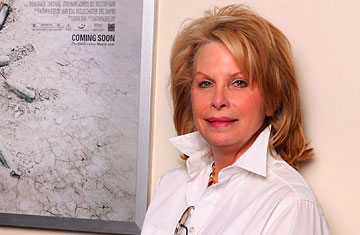
Hollywood publicist Ronni Chasen in Los Angeles on April 14, 2010
After eight months of rumors and speculation as to who killed Ronni Chasen and why the 64-year-old Hollywood publicist was targeted while she was driving her Mercedes sedan through Beverly Hills after the premiere of the movie Burlesque, the investigation into her murder has been officially concluded. The announcement last week from the Beverly Hills police brought a mixture of emotions from those closest to Chasen — and finally brought some answers.
The reality of Chasen's death was more tragically banal than many of the theories, which included her being involved in a business deal gone bad, having a dark family secret that led her to stiff one of her nieces in her will and being the victim of a contract killing. But what the Beverly Hills police insisted all along — and what Chasen's closest friend, Vivian Mayer-Siskind, now believes — is that Harold Smith, a 43-year-old career criminal, was the killer and that he acted alone. Chasen was simply extremely unlucky. "Ronni was in the wrong place at the wrong time, on a dark street where she was waiting for a light to turn, and a criminal was waiting in the dark for the next person alone in an expensive car. That's it," says Mayer-Siskind.
The single most important piece of evidence against Smith was the ballistics report, which showed that the gun used to kill Chasen was the same one he turned on himself when police went to his apartment building to question him. "That's as solid of evidence as you can have," Lieutenant Tony Lee of the Beverly Hills Police Department tells TIME.
Smith was an avid cyclist and worked at a Venice Beach bike shop — previously unreported details. When police first revealed that Smith, who didn't own a car, pedaled his bicycle from his low-rent apartment building in Hollywood across town to the corner of Sunset and Whittier, it simply wasn't believable to the many Angelenos who followed the case; that cast doubt on both the competence of the investigators and the likelihood that Smith had committed the crime. "But [the police] interviewed a lot of people, and this guy drove distances, major distances," says Mayer-Siskind. "I get in my car and turn on my ignition. This guy rode his bike." Death does not have to arrive on foot or by car; sometimes a cyclist can indeed be the perp.
Last, Smith had been convicted and served nine years of an 11-year prison sentence for an armed robbery in a Beverly Hills neighborhood near where Chasen was killed. "[Smith] held a woman at gunpoint when she was at her mailbox approximately 2½ miles south [of the Chasen crime scene], on Doheny and Olympic," Lee says. "She got out of her car, and he pulled a gun on her, and we caught him."
The official press release announcing the closure of the case lists the lengths to which Beverly Hills detectives went in investigating the crime: analyzing 150,000 e-mails and texts, reviewing video and closed-circuit-TV footage that established Chasen's route the night of her murder, following up on thousands of tips, dissecting Chasen's financial documents and those of persons of interest in the case. All told, detectives say they logged 10,000 hours of time working on the case. "We had a considerable amount of evidence indisputably pointing toward Harold Smith," Lee says. "We're 110% sure he committed the crime."
But not everyone in Chasen's inner circle was satisfied with how the investigation was handled while it was ongoing or feels a sense of closure now that the case is complete. "I never thought they were thorough enough," says Kathie Berlin, a close friend and former business partner of Chasen's, of the Beverly Hills Police Department. "They had very few press conferences, and friends of [Chasen's] were on their case all the time to follow up on information they had. Nobody felt the security of, 'This has been covered A to Z, and this is what happened.' " That led to doubts about the veracity of the investigators' conclusions. "I think most of us have accepted that it was a random act, but was it that guy? I don't know. I don't know," Berlin says.
As to one of the more outlandish rumors that circulated regarding the crime, a source close to Chasen who didn't want to be identified explained that the reason Chasen's niece Jill Gatsby was left out of her will wasn't a family secret. It was well known among her friends that when Chasen's mother was ill with cancer, Gatsby's sister visited the hospital twice a week while Gatsby didn't visit at all. "Ronni was devoted to her mother," the source says. "Ronni would say, 'Please visit,' and she never went."
The contract-killing rumor gained momentum after Smith's death, when some of his neighbors claimed he had bragged about killing Chasen and said he was expecting to receive a $10,000 payment for it. But the reality is that Smith had been involved in a traffic accident and was awaiting a settlement from a lawsuit. "It was a traffic-accident windfall," Lee says. "He was owed several thousand dollars."
Despite being sure the investigation was thorough, Mayer-Siskind says she understands why other friends of Chasen's might still have misgivings about the case. "I respect how other people feel about this not being conclusive for them. It was so surreal to me, and eight months later it continues to be so surreal, that I can understand if people say, 'Are you kidding me, the wrong place at the wrong time?' " she says. "I have reconciled it in my head based on the facts. But I will never reconcile it in my heart."
